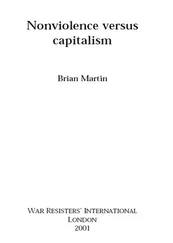Johan Galtung, “Why do disarmament negotiations fail?” Gandhi Marg , nos. 38-39, May-June 1982, pp. 298-307; Johan Galtung, There Are Alternatives! Four Roads to Peace and Security (Nottingham: Spokesman, 1984), pp. 131-138; Alva Myrdal, The Game of Disarmament: How the United States and Russia Run the Arms Race (New York: Pantheon, 1976). Among other factors, disarmament negotiations keep control over the agenda in the hands of the dominant governments and dampen public concern by giving the illusion that something is being done about the problem.
See, for example, Bonn International Center for Conversion, Conversion Survey 1996: Global Disarmament, Demilitarization and Demobilization (Oxford: Oxford University Press, 1996); Seymour Melman, The Demilitarized Society: Disarmament and Conversion (Montreal: Harvest House, 1988); Judith Reppy (ed.), Conversion of Military R&D (Basingstoke: Macmillan, 1998); Peter Southwood, Disarming Military Industries: Turning an Outbreak of Peace into an Enduring Legacy (Houndmills, Basingstoke: Macmillan, 1991); and the journal Positive Alternatives , published by the Center for Economic Conversion, 222 View Street, Mountain View CA 94041-1344, USA.
On the topics of policing, prisons and economics from the perspective of social defence, see Brian Martin, Social Defence, Social Change (London: Freedom Press, 1993).
I thank Andreas Speck for emphasising this point. A theoretical foundation for this approach is given by Nicholas Maxwell, who argues that most scientific and scholarly work is based on the “philosophy of knowledge,” which assumes that knowledge is of value in itself. Maxwell argues that the philosophy of knowledge should be replaced by a “philosophy of wisdom,” in which science is directly geared to solve major problems facing humanity, such as poverty, repression and war: Nicholas Maxwell, From Knowledge to Wisdom: A Revolution in the Aims and Methods of Science (Oxford: Basil Blackwell, 1984); Nicholas Maxwell, “What kind of inquiry can best help us create a good world?,” Science, Technology, & Human Values , Vol. 17, 1992, pp. 205-227.
Theories of technology are discussed in the appendix. The general model adopted here is that military and other social factors influence but do not determine technology, and that any specific technology is easier to use for some purposes than others.
General treatments of the influence of the military on science and technology include J. D. Bernal, The Social Function of Science (London: George Routledge & Sons, 1939), chapter VII; Robin Clarke, The Science of War and Peace (London: Jonathan Cape, 1971); Paul Dickson, The Electronic Battlefield (Bloomington: Indiana University Press, 1976); Everett Mendelsohn, “Science, technology and the military: patterns of interaction,” in Jean-Jacques Salomon (ed.), Science War and Peace (Paris: Economica, 1990), pp. 49-70; Everett H. Mendelsohn, Merritt Roe Smith and Peter Weingart (eds.), Science, Technology and the Military (Dordrecht: Kluwer, 1988); Robert K. Merton, Science, Technology and Society in Seventeenth Century England (New York: Howard Fertig, 1970 [1938]); John U. Nef, War and Human Progress: An Essay on the Rise of Industrial Civilization (London: Routledge & Kegan Paul, 1950); Merritt Roe Smith (ed.), Military Enterprise and Technological Change: Perspectives on the American Experience (Cambridge, MA: MIT Press, 1985). References to specific areas are given later. On arms production and trade, see William W. Keller, Arm in Arm: The Political Economy of the Global Arms Trade (New York: HarperCollins, 1995); Keith Krause, Arms and the State: Patterns of Military Production and Trade (Cambridge: Cambridge University Press, 1992).
See for example Matthew Evangelista, Innovation and the Arms Race: How the United States and the Soviet Union Develop New Military Technologies (Ithaca, NY: Cornell University Press, 1988); Wim A. Smit, John Grin and Lev Voronkov (eds.), Military Technological Innovation and Stability in a Changing World: Politically Assessing and Influencing Weapon Innovation and Military Research and Development (Amsterdam: VU University Press, 1992).
Janet Abbate, Inventing the Internet (Cambridge, MA: MIT Press, 1999); Paul N. Edwards, The Closed World: Computers and the Politics of Discourse in Cold War America (Cambridge, MA: MIT Press, 1996); Paul Forman, “Behind quantum electronics: national security as basis for physical research in the United States, 1940-1960,” Historical Studies in the Physical and Biological Sciences , Vol. 18, No. 1, 1987, pp. 149-229; Brian Martin, “Computing and war,” Peace and Change , Vol. 14, No. 2, April 1989, pp. 203-222.
Donald MacKenzie, “The influence of the Los Alamos and Livermore National Laboratories on the development of supercomputing,” Annals of the History of Computing , Vol. 13, No. 2, 1991, pp. 179-201.
Robert DeGrasse, “The military and semiconductors,” in John Tirman (ed.), The Militarization of High Technology (Cambridge, MA: Ballinger, 1984), pp. 77-104.
Donald MacKenzie and Graham Spinardi, “The technological impact of a defence research establishment,” in Richard Coopey, Matthew R. H. Uttley and Graham Spinardi (eds.), Defence Science and Technology: Adjusting to Change (Chur, Switzerland: Harwood Academic Publishers, 1993), pp. 85-124.
John H. Perkins, “Reshaping technology in wartime: the effect of military goals on entomological research and insect-control practices,” Technology and Culture , Vol. 19, No. 2, April 1978, pp. 169-186.
Christopher Simpson, Science of Coercion: Communication Research and Psychological Warfare 1945-1960 (New York: Oxford University Press, 1994). I thank Mary Cawte for drawing this book to my attention.
Douglas D. Noble, The Classroom Arsenal: Military Research, Information Technology, and Public Education (London: Falmer Press, 1991).
Susan Wright and Stuart Ketcham, “The problem of interpreting the U.S. biological defense research program,” in Susan Wright (ed.), Preventing a Biological Arms Race (Cambridge, MA: MIT Press, 1990), pp. 169-196.
Mark Diesendorf, “On being a dissident scientist,” Ockham’s Razor 2 (Sydney: Australian Broadcasting Corporation, 1988), pp. 9-14, at p. 10.
Quoted in Stuart W. Leslie, The Cold War and American Science: The Military-Industrial-Academic Complex at MIT and Stanford (New York: Columbia University Press, 1993), p. 238.
Joseph O’Connell, “Metrology: the creation of universality by the circulation of particulars,” Social Studies of Science , Vol. 23, No. 1, February 1993, pp. 129-173. Andreas Speck gives the additional example that standards for German roads and airport runways — such as the width and the strength of the base — are set by military criteria.
Daniel S. Greenberg, The Politics of Pure Science (New York: New American Library, 1971); Gregory McLauchlan, “The advent of nuclear weapons and the formation of the scientific-military-industrial complex in World War II,” in Gregg B. Walker, David A. Bella and Steven J. Sprecher (eds.), The Military-Industrial Complex: Eisenhower’s Warning Three Decades Later (New York: Peter Lang, 1992), pp. 101-127.
Читать дальше












